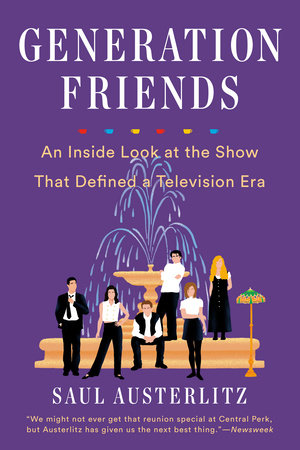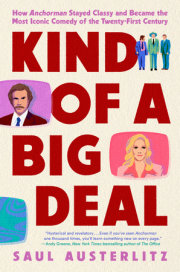Chapter 1
Insomnia Cafe
A TV Show Is Born
One day in late 1993, a young television writer named Marta Kauffman was driving along Beverly Boulevard when she passed a funky coffee shop called Insomnia CafŽ, located across the street from an Orthodox synagogue. Full of lumpy couches and garish chairs, strings of Christmas lights, and towering bookshelves piled high with mismatched books, the place was a beacon calling to the artists and slackers of the Fairfax-La Brea area. Kauffman, who lived nearby in Hancock Park, was trawling for ideas that could be transformed into stories for the upcoming pilot season.
Along with her writing partner David Crane, Kauffman had created the groundbreaking HBO series Dream On and, after leaving the show, had been fruitlessly seeking network success. Last pilot season had been disappointing, and it was important to the two writers that 1994 be a better year for them than 1993 had been. Something about Insomnia CafŽ grabbed her attention, and she began to mull over an intriguing idea. Could a comedy series set in a coffee shop appeal to viewers? Kauffman and Crane had only recently moved to California from New York, and found that they missed their old crew of friends from Manhattan terribly. They had spent all their spare time together, done everything together, served as a kind of surrogate family. What if they put together a show about that?
Sometime in the mid-1980s, Warren Littlefield discovered something new about television. The NBC executive, protŽgŽ to network president Brandon Tartikoff, was attending an advertising meeting, and the research department displayed a gridded chart showing the relative audience shares for two shows: CBSÕs Murder, She Wrote and NBCÕs own St. Elsewhere. At the bottom left, Murder, She Wrote, featuring Angela Lansbury as a crime-solving mystery novelist, a fixture in the Nielsen top ten, and at the top right, NBCÕs quirky hospital drama, beloved by critics but lagging noticeably in the ratings. The message was clear: NBCÕs niche effort was having its clock cleaned. What came next changed LittlefieldÕs entire career.
If you think Murder, She Wrote is kicking St. Elsewhere's ass, the researcher continued, you're right-when it comes to total audience. Now a new graph replaced the initial chart. This one showed the fees networks charged advertisers for their shows. Quirky, niche, never-gonna-be-a-hit St. Elsewhere made NBC more money than the far more successful Murder, She Wrote made for CBS. NBC was able to charge more for its thirty-second spots than CBS charged for theirs.
And why? The answer lay in a steady shift in advertisers' interests. Advertisers increasingly preferred younger eyeballs. Reaching a mass audience was too diffuse and too unpredictable. Advertisers preferred a targeted approach, pushing their sports cars and light beers to youthful viewers, whom they believed to be more likely to purchase them. The ratings were no less important today than they had been yesterday, but the youth market-broadly speaking, viewers between the ages of eighteen and forty-nine-was becoming the only market that really mattered. (Older people, the thinking went, could be safely ignored, being unlikely to buy the razors and sports cars and beer advertisers hoped to sell.) Littlefield understood that the ground was shifting in network television.
Littlefield had been studying government at American University in Washington, DC, during the final years of Richard Nixon's presidency, imagining himself rescuing American democracy from unconstitutional knavery. When Nixon resigned, the urgency of Littlefield's cause dissipated, and he switched to studying psychology. Before beginning a graduate program, he wanted to accrue some work experience and was offered a job by a hometown friend as a gofer at a production company.
After stints as a location scout and an assistant editor, Littlefield was acquiring properties of his own for production. He was feeding original movies to the gaping maw of the networks, which had approximately three hundred such slots to fill on their yearly calendars. One such effort, an East Africa-set adventure called The Last Giraffe, was selected by The Hollywood Reporter as one of the ten best TV movies of 1979, and Littlefield decided it was time to relocate to Los Angeles. He soon took up a job at NBC in comedy development and began his meteoric rise at the network.
Just a few years after the St. Elsewhere epiphany, Littlefield was named the president of entertainment at NBC, replacing Tartikoff. Littlefield was inheriting a network that was simultaneously flourishing and endangered. Under the tutelage of the highly esteemed Tartikoff, NBC had dominated the 1980s with series like Cheers, The Cosby Show, and L.A. Law. Tartikoff had been skeptical about a new series from two comedians named Jerry Seinfeld and Larry David ("too New York and too Jewish," said the New York Jew) but developed the acerbic, high-concept, defiantly unlikable Seinfeld anyway.
Now Littlefield had succeeded Tartikoff and was watching as the network's most beloved series were leaving the air. The Cosby Show had ended, Cheers was ending, and NBC's historic run of dominance on Thursday nights was running the risk of coming to an end. NBC needed to develop some new shows, and Littlefield's newfound fixation on younger audiences found him constructing a mental graph of his own. The x-axis was the mass market; the y-axis was the youth audience. Littlefield was aiming to simultaneously maximize both, creating shows that were appealing to younger viewers without turning away older audiences.
As Littlefield was pondering his future audience, Bill Clinton was close to wrapping up his first year as president and soon to face a wipeout in the 1994 midterms, in which Republicans would gain fifty-four seats and make Newt Gingrich Speaker of the House. The Soviet Union had collapsed two years prior, leaving the United States as the sole world superpower. Democracy had seemingly won its titanic struggle with world communism without firing a shot. The American way of life was ascendant.
The sports world was about to be rocked by the news that, for the first time in ninety years, there would be no World Series played that fall, due to a labor strike. Quentin Tarantino won the Palme d'Or at Cannes for his neo-Godardian crime film Pulp Fiction, which resuscitated the moribund career of John Travolta, and the dominant film of the summer would be the overpraised, conservative Forrest Gump, in which Tom Hanks's title character was present at much of postwar American history while serving as proof that all was as it should be. Independent film was ascendant, with Miramax, run by the later-to-be-disgraced Harvey Weinstein, leading a phalanx of new voices with films like The Crying Game. In the mid-1990s, film was still considered the primary visual medium of the American arts, attracting exciting new voices like Tarantino, Todd Haynes, John Singleton, and Allison Anders. Television, by comparison, while it had produced exciting new series like Seinfeld and NYPD Blue, was considered a backwater, a place you went when the movies didn't work out, whose audience was far less discerning than film's.
Meanwhile, a coffee company that had originally been started by two teachers and a writer in Seattle had begun to expand beyond the Pacific Northwest. Starbucks had opened stores in Portland and Chicago, and then targeted California, tackling San Francisco and Los Angeles. The company had gone from eleven stores in 1987 to one hundred sixty-one stores only five years later. Coffee was suddenly big business, and Starbucks was rapidly becoming the name most prominently associated with coffeehouse culture. With its oversize plush chairs, its soothing soundtrack of folk, indie rock, and world music, and its distinct language (who decided that a "tall" would be one of the smaller sizes for its drinks?), what had once been associated with college campuses and Greenwich Village was soon to be a nationwide phenomenon. Coffee was no longer solely a matter of dumping hot water into powder over the kitchen sink; it was now an entire lifestyle, with a culture of (occasionally harried) leisure to accompany it. Young Americans would not just drink coffee for a burst of caffeine; they would lounge around in coffeehouses, bantering, laughing, and trading confidences, seizing on the relatively new spaces forming in cities across the nation and making them their own.
As president, Littlefield was carrying with him the message he had received from the legendary former NBC CEO and chairman Grant Tinker earlier in his career. Tinker had continually sought to remind Littlefield and his colleagues that the audience was not an alien race. What shows were his employees breathlessly anticipating each week? What series would convince them to cancel their plans and rush home, in this pre-streaming era, to catch the latest episode? Those were the shows they should be making. It was time for stories that spoke to the audiences they craved, that were about young people.
And if the story of the sitcom could be said to have followed an arc, one of the major changes that had unfolded across the four decades of television history had been the shift away from the family show. Television had begun as a domestic medium, a place for families to gather in their living rooms to watch other, fictional families in their living rooms. It had been a feminine counterpoint to the increasingly masculine sphere of the movies. But over time, the domestic families of Father Knows Best and Leave It to Beaver had given way to the workplace families of The Mary Tyler Moore Show and M*A*S*H.
With the American family dissolving and re-forming in unimaginable new patterns, the sitcom increasingly preferred its groupings of colleagues and squads. The 1980s had seen a resurgence of the family sitcom, with the former B-movie-star-turned-national-father-figure Ronald Reagan inspiring a wave of sturdy sitcom dads like The Cosby Show's Heathcliff Huxtable and Family Ties' Steven Keaton. Ratings indicated that younger audiences, less likely to be married or raising children, mostly preferred to see themselves reflected on their television screens, and even older, married viewers were often happier watching a crew of friends bantering.
Seinfeld was a show like that. The specials department at NBC, not the prime-time programming team, had picked up the pilot in 1989. Rick Ludwin and his group had fallen in love with a stand-up comedian named Jerry Seinfeld. Seinfeld and fellow comedian Larry David had spent an afternoon walking around a Manhattan deli and talking about the strange products on display there, belatedly realizing that their aimless banter could form the foundation of a new kind of television series. The pilot flopped with audiences, and NBC expressed little enthusiasm for the show, but Ludwin's fierce advocacy bankrolled a four-episode run, and eventually got it an invitation for a fuller second season.
Seinfeld rewrote the rules of the sitcom. Its characters were amoral, callous, and self-centered. There were no meaningful romantic relationships on the show; the one partnership heading toward marriage would later be brutally, hilariously interrupted by a batch of poisoned envelopes. And yet, NBC understood that part of the attraction of Seinfeld was its aura of charming Manhattan singles in pursuit of true love-or at least a fruitful one-night stand. Much of Seinfeld was turned over to the logistics and limitations of big-city dating, with many of its most memorable moments, from "They're real, and they're spectacular" to "Not that there's anything wrong with that," stemming from relationship stories. People enjoyed watching George and Elaine and Kramer sitting on Jerry's couch and bantering, and NBC was betting that there was a huge untapped market for series similar to Seinfeld, the third-highest-rated series of the 1993-94 season after 60 Minutes and Home Improvement. The search for the next Seinfeld was on.
Each morning at six o'clock, Littlefield received a fax from the research department, based in New York, with the overnight ratings. It was like a daily report card, delivering updated assessments of the audience's feelings regarding NBC programming. As Littlefield perused the overnights from San Francisco and Houston and Atlanta, he thought about what it must be like to be a young person starting a life in one of those places. Rent was expensive, jobs were scarce, and moving somewhere new, beyond the reach of parents and old friends, could be lonely. Littlefield considered his own formative postcollege years, living with roommates in the suburbs of New York and taking the commuter train to work daily. It had been harsh and unromantic, but it had also been a testing ground. To be young was to scuffle, but it was also to discover the world afresh. ABC was flying high with blue-collar comedies like Roseanne and Home Improvement, and CBS was devoted to its older audience, seemingly unaware of the advertising pot of gold that Littlefield was chasing. No one was serving the younger viewers Littlefield had in mind.
Littlefield put out a call to writers and producers he had worked with: Bring me ideas for shows about young people. He was in search of stories about breaking away, about stepping out, about finding yourself. Littlefield was convinced that older audiences could easily be compelled to watch a show in which they communed with their younger selves, but younger audiences could never be cajoled to watch characters living lives they had not yet experienced. Littlefield didn't want any more pitches about crusading lawyers or wholesome single dads; he wanted clever, warmhearted shows with instantly recognizable characters. He wanted a kinder, gentler Seinfeld-less New York and less Jewish (while maybe still retaining some of the original's Semitic, five-boroughs appeal). He didn't get it.
The first batch of pitch meetings came and went, and a few scripts were given the green light for development, but nothing of substance propelled itself forward. None of them felt unique, and Littlefield went about his business, conscious that there was an opportunity that might vanish. Another network might grab the reins, and NBC's chance to win over a new generation of viewers, and the resulting advertising dollars, might dissipate.
For television writers, pilot season, the weeks when writers proposed new concepts for television series to the networks bidding for their services, was a hectic flurry of all-night writing sessions and snap decisions that even the people involved could hardly remember. To maximize oneÕs options, it was customary for working writers to pitch two, or even three, pilots to networks, in the hopes that one might catch fire. Marta Kauffman and David Crane were hoping to expunge the bad taste that still lingered in their mouths from the preceding season.
Jeff Sagansky at CBS had been happy to listen to Crane and Kauffman's pitches during the 1993 pilot season, including an idea for a musical show with original songs each week, but had his own ideas. He was looking for a white-collar version of the bickering, loving family of Roseanne, he told them, and was not much interested in anything else. Kauffman and Crane came back with Family Album, which was meant to fulfill Sagansky's desire.
Copyright © 2019 by Saul Austerlitz. All rights reserved. No part of this excerpt may be reproduced or reprinted without permission in writing from the publisher.







